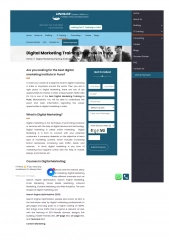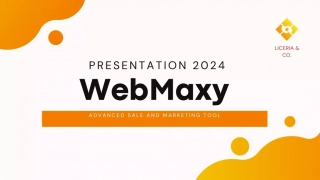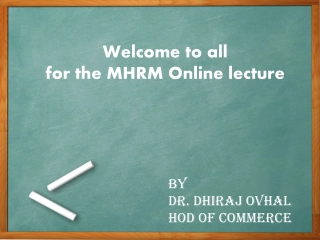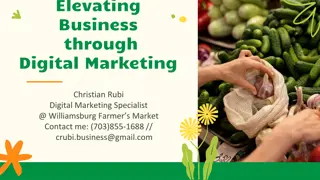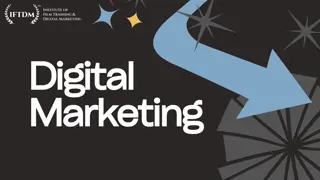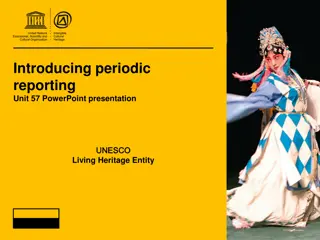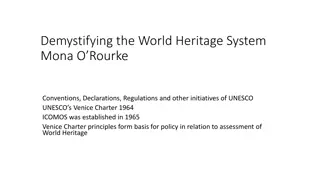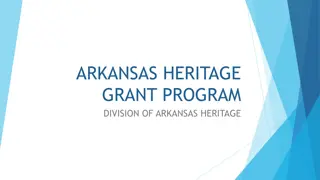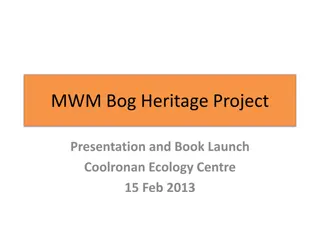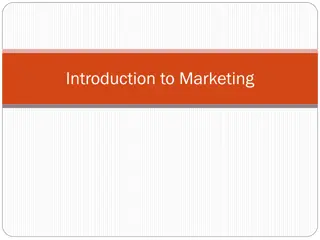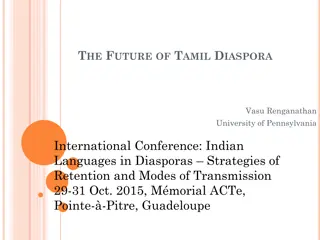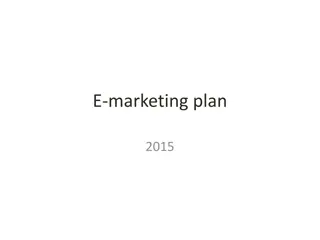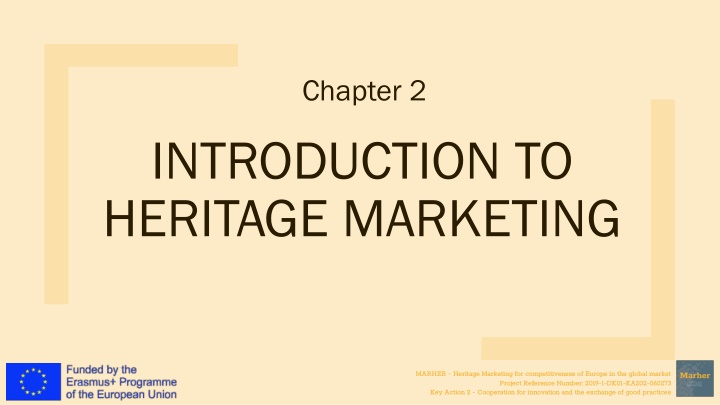
Heritage Marketing: Definitions and Evolution
Explore the concepts and evolution of heritage marketing in Europe, delving into the social significance and collective values passed down through generations. Discover the expansion of the heritage concept from tangible to intangible elements over time.
Uploaded on | 1 Views
Download Presentation

Please find below an Image/Link to download the presentation.
The content on the website is provided AS IS for your information and personal use only. It may not be sold, licensed, or shared on other websites without obtaining consent from the author. If you encounter any issues during the download, it is possible that the publisher has removed the file from their server.
You are allowed to download the files provided on this website for personal or commercial use, subject to the condition that they are used lawfully. All files are the property of their respective owners.
The content on the website is provided AS IS for your information and personal use only. It may not be sold, licensed, or shared on other websites without obtaining consent from the author.
E N D
Presentation Transcript
Chapter 2 INTRODUCTION TO HERITAGE MARKETING MARHER MARHER - - Heritage Marketing for competitiveness of Europe in the global market Heritage Marketing for competitiveness of Europe in the global market Project Reference Number: 2019 Project Reference Number: 2019- -1 1- -DK01 Key Action 2 Key Action 2 - - Cooperation for innovation and the exchange of good practices Cooperation for innovation and the exchange of good practices DK01- -KA202 KA202- -060273 060273
HERITAGE MARKETING Definitions and evolution of concepts
WHAT IS HERITAGE? MARHER MARHER - - Heritage Marketing for competitiveness of Europe in the global market Heritage Marketing for competitiveness of Europe in the global market Project Reference Project Reference Number Key Action 2 Key Action 2 - - Cooperation for innovation and the exchange of good practices Cooperation for innovation and the exchange of good practices Number: 2019 : 2019- -1 1- -DK01 DK01- -KA202 KA202- -060273 060273
HERITAGE MARKETING The word HERITAGE has Latin origins and deals with the terms heres (literally inheritance) and patrimony (which derives from the union of pater and munus, and means the duty of the fathers ). These words do not refer only to the inheritance of property, but also to everything that the past has transmitted to the present; therefore, the meaning is not relating only to the individual sphere, but also to the collective one. Considering that, heritage has a social significance and is therefore capable of expressing the identity and meaning of a territory, as well as of an organization. So the concept of heritage involves the set of material and immaterial values that the past has transmitted to today.
EVOLUTION OF THE CONCEPT Over time, the concept of heritage has expanded its boundaries: there has been, in fact, an extension from the tangible to the intangible and from the outstanding universal value to the testimonies of human civilization. We can retrace the evolution stages of the concept of heritage thanks to the definitions present in some international conventions (particularly UNESCO and the Council of Europe)
YEAR YEAR CONVENTION CONVENTION ORGANIZATION ORGANIZATION THE CONCEPT OF CULTURAL HERITAGE THE CONCEPT OF CULTURAL HERITAGE This document introduces for the first time the term cultural property property and extends the category of cultural objects worthy of protection from previous documents, which were mostly "historical monuments", "works of art" and "works of science". Convention for the Protection of Cultural Property in the Event of Armed Conflict - The Hague cultural 1954 UNESCO This document is the first legal recognition of the strong connection between culture and nature. The definitions of Cultural Heritage and Natural Heritage offered by the 1972 Convention declared that only what is of Outstanding Universal Value Outstanding Universal Value was worthy of protection. Convention Concerning the Protection of the World Cultural and Natural Heritage - Paris 1972 UNESCO This document introduces an integrated and transversal vision of the landscape landscape and the perceptive factor of the population in recognition of the landscape (hoping for the participation of communities in landscape policies); extends the concept of landscape not only to excellences, but also to landscapes of everyday life and degraded ones. 2000 European Landscape Convention - Florence Council of Europe This document extends the concept of Cultural Heritage to the intangibl intangible e one and considers it a living expression to be safeguarded in its evolution. Convention for the Safeguarding of the Intangible Cultural Heritage - Paris 2003 UNESCO This document defines cultural heritage as a set of resources inherited from the past and shifts the focus from how and what to protect, to why and for whom to enhance , revolutionizing the traditional approach to cultural heritage. It also provides for the overcoming of a top-down approach to accommodate the bottom-up approach, making people active subjects in cultural life. resources Convention on the Value of Cultural Heritage for Society - Faro 2005 Council of Europe
EVOLUTION OF THE CONCEPT 2005 Faro Council of Europe A set of resources resources inherited from the past 2003 Paris UNESCO Intangible Intangible Cultural Heritage 2000 Florence Council of Europe Integrated and transversal vision of the landscape landscape 1972 Paris UNESCO Outstanding Outstanding universal Value universal Value 1954 The Hague UNESCO Cultural property Cultural property
CORPORATE HERITAGE Starting from the broader concept of cultural heritage defined by the Faro Convention, we can say that the corporate corporate heritage heritage is a resource and it can be enhanced and used to promote the company and its products, but also to preserve and enhance the cultural heritage of the territory where the company is located.
WHAT IS MARKETING? MARHER MARHER - - Heritage Marketing for competitiveness of Europe in the global market Heritage Marketing for competitiveness of Europe in the global market Project Reference Project Reference Number Key Action 2 Key Action 2 - - Cooperation for innovation and the exchange of good practices Cooperation for innovation and the exchange of good practices Number: 2019 : 2019- -1 1- -DK01 DK01- -KA202 KA202- -060273 060273
HERITAGE MARKETING The activities that take place at the interface between an organization and its customers. Marketing is the process that plans and carries out the design, the policy of pricing, promotion and distribution of ideas, goods and services aimed at creating market and to meet the goals of individuals and organizations. The goal is to get potential customers to choose to carry out their transactions with their organization. The growing role of marketing in a broader social context, seems to consider customers more than purely passive consumers . The responsibility of those involved in marketing is to ensure that the customer is firmly placed in the first place in the thoughts of the company. MARHER MARHER - - Heritage Marketing for competitiveness of Europe in the global market Heritage Marketing for competitiveness of Europe in the global market Project Reference Project Reference Number Key Action 2 Key Action 2 - - Cooperation for innovation and the exchange of good practices Cooperation for innovation and the exchange of good practices Number: 2019 : 2019- -1 1- -DK01 DK01- -KA202 KA202- -060273 060273
The Development of the Marketing Concept Business activities are focused on improving production processes and reduction of procurement costs, as well as obtaining a capillary distribution. Production Orientation Starts from the assumption that consumers give their preference to offers of higher quality, better performance and innovative features. Product orientation Argues that customers generally will not purchase the firm's products in sufficient volumes to meet needs companies and that, therefore, it will be necessary to convince them to buy more. Sales orientation States that to reach the objectives of the company, it must be more effective than its competitors in creating value for customers. Marketing orientation MARHER MARHER - - Heritage Marketing for competitiveness of Europe in the global market Heritage Marketing for competitiveness of Europe in the global market Project Reference Project Reference Number Key Action 2 Key Action 2 - - Cooperation for innovation and the exchange of good practices Cooperation for innovation and the exchange of good practices Number: 2019 : 2019- -1 1- -DK01 DK01- -KA202 KA202- -060273 060273
The Development of the Marketing Concept Rather than the stock market, the proportion of each client's portfolio is targeted, with the goal of capturing a larger share of each customer's spending, ensuring greater loyalty and focusing on the long-term value of the customer relationship. Customer orientation The goal of the business is to discover customer demands and market interests, as well as to get customer satisfaction more efficiently and effectively than competitors, while also preserving or improving the consumer's and society's well-being. Social marketing orientation Marketers will take responsibility for their ability to build and sustain long-term connections with their customers. In fact, relational marketing has had the most success in the business-to- business sector. Relational marketing MARHER MARHER - - Heritage Marketing for competitiveness of Europe in the global market Heritage Marketing for competitiveness of Europe in the global market Project Reference Project Reference Number Key Action 2 Key Action 2 - - Cooperation for innovation and the exchange of good practices Cooperation for innovation and the exchange of good practices Number: 2019 : 2019- -1 1- -DK01 DK01- -KA202 KA202- -060273 060273
Marketing and Other Business Functions If the client is at the center of the organization's thoughts, marketing personnel must assume the position as mediators. As a result, marketing may be perceived through a variety of angles. As a mediating force in the exchange process. As the driving philosophy of the company. As a managerial function. As a dynamic activity, which requires analysis, planning and action. As a catalyst for change. MARHER MARHER - - Heritage Marketing for competitiveness of Europe in the global market Heritage Marketing for competitiveness of Europe in the global market Project Reference Project Reference Number Key Action 2 Key Action 2 - - Cooperation for innovation and the exchange of good practices Cooperation for innovation and the exchange of good practices Number: 2019 : 2019- -1 1- -DK01 DK01- -KA202 KA202- -060273 060273
HERITAGE MARKETING Taking into account previous concepts, Heritage a management philosophy and process aimed at: Rediscovering, preserving and enhancing the historical heritage of the company and of the place of production sharing cultural, emotional and symbolic values with stakeholders. Heritage Marketing Marketing is
WHY HERITAGE MARKETING? Main reasons
1. 1. ECONOMIC ECONOMIC & & STRATEGIC have a unique and inimitable competitive advantage; differentiate oneself from the competitors; building or increasing the strength and reputation of the corporate identity; meet the demands of the post-modern consumer who is increasingly looking for authenticity and experiences; innovate by using knowledge derived from heritage; STRATEGIC REASONS REASONS:
2 2. . SOCIAL SOCIAL & & ETHICAL preserving and passing on cultural heritage to future generations; develop total relationship marketing (i.e. both internally, with staff, and externally, with customers, collaborators, financiers...); ETHICAL REASONS REASONS:
Therefore, Heritage Marketing strategies offer opportunities to create (economic and social) value for the company, but also for society and the production area. It is a socially responsible way of marketing.
HERITAGE MARKETING Context
CONSUMPTION IN THE CURRENT SOCIO-ECONOMIC CONTEXT: EXPERIENCE In the current context, consumption has changed. Today, consumption is no longer determined solely by needs, but also by the pursuit of well-being and pleasure, which is why emotions and experiences become central to marketing. Consumers do not just buy products, but also the meanings, symbols and values associated with them. Furthermore, consumption becomes an opportunity for personal experience and a useful element in defining the identity of the individual.
EXPERIENCE IN HERITAGE MARKETING The enhancement of heritage allows the company to: offer experiences, involve the customer and all the senses, favour emotions and the search for affective ties, stimulate cognitive processes, promote the active encouraging immersion and communication. participation of customers,
CONSUMPTION IN THE CURRENT SOCIO-ECONOMIC CONTEXT: AUTHENTICITY In contemporary society is experiencing a sense of emptiness and overload that leads it to seek authenticity and traditional values. the current context of globalisation phenomena,
AUTHENTICITY IN HERITAGE MARKETING The search for roots and an authentic life can also be found in consumption. The consumer is looking for authentic products, so products that have a link with the place of production and its genius loci. Heritage marketing aims to enhance and leverage precisely these characteristics.
HERITAGE MARKETING Process
A strategy can be successful if it has a clear, shared and coherent vision and SMART (Specific, Measurable, Achievable, Relevant, Time based) objectives. It is therefore essential to implement the strategy from the very beginning. For this reason a heritage marketing strategy development and implementation model (created by A. Riviezzo, A. Garofano, M.R. Napolitano) is proposed here: 1. Auditing 1. Auditing: analysis of the identity of the company and of the stakeholders to identify the cultural heritage factors on which to leverage 2. Visioning: 2. Visioning: definition of the vision, specific targets and narratives 3. Managing 3. Managing: definition of the managerial, organisational and financial aspects 4. Controlling 4. Controlling: monitoring of results in relation to the goals
1. Auditing This phase has two purposes: 1. to identify heritage elements with core values for the company; It is necessary to collect as much data and information as possible on the organisation s life, in order to identify the foundations of the company's identity and thus all factors that have been crucial for development in the past, and that might be critical for the present and the future. Both objective evidence (e.g. archival documents) and information related to stakeholder perceptions (e.g. interviews) should be used. 2. to make a stakeholder analysis. It is important to analyse the personal experiences and perceptions of people who have been part of the organisation (owner, employees, collaborators...) and also of consumers as the events within the company's history may have been significant for those who experienced them.
2. Visioning Once the elements that characterise the identity of the company have been identified, the strategy can be defined. 1. The first step is to establish a shared vision brand identity of the company. The second step is to identify the target internal stakeholders ((managers, employees, collaborators...): heritage marketing can help the understanding, dissemination and sharing of corporate culture among all those working in the company. external stakeholders (customers, suppliers, lenders...): heritage marketing can be fundamental in building and consolidating a company's reputation. It can attest to aspects such as the reliability and solidity that the company has had over time. vision of the role of heritage in the management and 2. target audience. The company can use its heritage for: The strategic objectives and targets may be many and varied. It is necessary to clearly identify these elements in order to then define the operational tools to be used.
3. Managing In this third phase the company must develop its organisational and financial strategy. Therefore it is necessary to define: what and how to narrate, the budget, organisational responsibilities, operational tools (e.g. Heritage Marketing Mix)
4. Controlling This last phase of the process involves monitoring them, taking into account the objectives set. monitoring the results and evaluating evaluating One system that could be used for monitoring is that of key indicators indicators, which allows results to be monitored and evaluated on an ongoing basis. key performance performance In this way, it is also possible to identify potential negative signals and to correct correct them.
HERITAGE MARKETING Tools
STORYTELLING It is not enough to have a story to make it a competitive advantage. Once you have identified the elements and the values you want to leverage, you have to know how to communicate them. The tool par excellence is storytelling (more on this in Chapter 3). Storytelling Storytelling is the vivid description of ideas, beliefs, personal experiences, and life lessons through stories or narratives that evoke powerful emotions and insights [Serrat, 2008].
HERITAGE MARKETING MIX One of the operational tools that can be used is the Heritage Marketing Mix (A. Riviezzo, A. Garofano, M.R. Napolitano, 2021). Thanks to storytelling, it is possible to communicate narratives through different medium: NARRATING THROUGH WORDS, IMAGES, SOUNDS NARRATING THROUGH PRODUCTS AND BRAND HERITAGE MARKETING MIX NARRATING THROUGH CELEBRATIONS AND RELATIONSHIP NARRATING THROUGH PLACES
NARRATING THROUGH WORDS, IMAGES, SOUNDS Companies monographs Corporate videos Special occasions and thematic publications Historic film and video clips Feature-lenght documentaries and films Leaflets, brochures, handouts House newsletters and magazines Websites Collection, reprint and re-release of historic media coverage Social networks Blogs, forums, online communities Re-use of historic advertising
COMPANIES MONOGRAPHS In 2005, Fabbri 1905, an Italian food company operating in the confectionery, ice cream and pastry sector, published Cento anni Fabbri 1905-2005 , a business monograph. As well as telling the story of the company, the monograph features historical documents, photos and advertisements and also traces the evolution of the iconic vase they use for packaging, a distinctive feature of the company. This book was an opportunity to collect and reorder the memories of a century of activity, but always with an eye to the future.
CORPORATE VIDEOS CORPORATE VIDEOS Corporate videos are simply videos produced by a business or a company. They re mainly used to promote and grow a company s brand. They serve main purposes: 1. 1. New product or service demonstrations. New product or service demonstrations. 2. 2. Event summaries. Event summaries. 3. 3. Client and customer testimonial videos. Client and customer testimonial videos. 4. 4. Interviews with company leaders. Interviews with company leaders. Corporate videos are planned to turn long or boring information into exciting and easy-to- understand information. image source
CORPORATE VIDEOS: EXAMPLES Video presentation of Androuet. Video shot in the Androuet cheese dairies in Paris and Neuilly. A meeting with St phane Blohorn, master cheesemaker and owner of Androuet since 2005.
NARRATING THROUGH PRODUCTS AND BRAND Heritage production processes Original raw materials Distinctive skills Iconic products Heritage branding Visual identity Retrobranding Limited editions Packaging Merchandising materials
PACKAGING PACKAGING The Ci Ci winery has dedicated one of its wines to the "Merlettaie", lacemakers. Through images, the label recounts a typical tradition of the town where the wine is produced, Offida (Italy). image source
RETROBRANDING RETROBRANDING We define retrobranding as the revival or relaunch of a product or service brand from a prior historical period product or service brand from a prior historical period, which is usually but not always updated to contemporary standards of performance, functioning, or taste. Retro brands are distinguishable from nostalgic brands by the element of updating. [Journal of Marketing] revival or relaunch of a Retrobranding research is based on the fact that brand allegories are stories, narratives or metaphors extended in a symbolic form. Six key features give value to brands: 1. Dormancy 2. Iconicity 3. Evocativeness image source 4. Utopianism 5. Solidarity 6. Perfectibility
RETROBRANDING RETROBRANDING EXAMPLE: EXAMPLE: THE PORSCHE CASE THE PORSCHE CASE They say. By using historical cars from our collection, we are not only showcasing the functionality of Porsche sports cars but, more importantly, conveying the fascination for Porsche in an authentic way all around the globe as a brand ambassador. We are increasingly developing our own formats to allow media reporting from an entirely new angle (Heritage Experience) and in order to convey internationally important product and corporate messages (Heritage Concepts). In doing so, our goal is to always sharpen the understanding of the origins of the Porsche brand. image source image source
NARRATING THROUGH PLACES Archives Museums Foundations Factory tours Industrial archaeology Sales points Historic headquarters, factories, plants Other associated lands, structures and properties
Museums Museums Examples: The The Museum Museum of to failed love relationships. It also includes personal object left over from lovers, accompanied by brief descriptions. of Broken Broken Relationships Relationships is a museum based in Croatia, dedicated
DUCATI MUSEUM DUCATI MUSEUM Another example is given by the Ducati Museum Museum: the guided tour of the factory tells an incredibly effective and consistent identity and values of a brand, from the origins to the present and with a look towards the future. A narration made through the people who daily work in Ducati can involve different targets. A 360 degrees experience that, combined with a store, has positive effects also at an economic level Ducati image source
FACTORY TOURS Example: Pinhais, a century-old canning industry, opens the Conservas Pinhais factory tours aimed at making known the material heritage to safeguarding its memory.
NARRATING THROUGH CELEBRATIONS AND RELATIONSHIP Anniversary events Temporary exhibitions, displays Convention, workshop Other cultural events Participation in events organised by others Sponsorship Participation in associations
ANNIVERSARY EVENT ANNIVERSARY EVENT For the 100th anniversary of the famous N 5 perfume, Chanel organised an event and exhibition at the Rockefeller Center in New York City under the title "N 5 in the stars". In addition, it made this video to celebrate the success of this product, retracing the historical stages that made it so. https://www.chanel.com/it/about- chanel/le-storie/ image source image source
OTHER CULTURAL EVENTS EXAMPLE: image source The great industry: "INKARAS" Factory is an event that shows some Kaunas images to convey an alternative narrative about our history and identity. The aim is to discover new senses in the history of the industry forgotten, erased, denied.
REFERENCES M. Cerquetti, A. Romagnoli, Towards Sustainable Innovation in Tourism. The Role of Cultural Heritage and Heritage Communities (overcoming) V. Martino, Dalle storie alla storia d impresa. Memoria, comunicazione, heritage, 2013 M.M. Montella, I musei d impresa. Heritage e total relationship marketing, 2018 M.R. Napolitano, A. Riviezzo, A. Garofano, Heritage Marketing. Come aprire lo scrigno e trovare un tesoro, 2018 A. Riviezzo, A. Garofano, M.R. Napolitano, Corporate Heritage Marketing. Using the past as a strategic asset, 2021
FURTHER READINGS J. Balmer, Corporate heritage, Corporate Heritage marketing and Total Corporate Heritage Communications: What are they? What of them?, 2013 J. Balmer, S. Greyser, M. Urde, Corporate brands with a heritage, 2007 M. Burghausen , J. Balmer, Corporate heritage identity management and the multi-modal implementation of a corporate heritage identity, 2014 A. De Nisco, M.R. Napolitano, Cultural heritage: the missing link in the place marketing literature chain , 2017 E. Donia, M. Mineo, F. Sgroi, Marketing Strategies the Agrifood Products, 2020 F. Iannone, Quando il museo comunica l impresa: identit organizzativa e sensemaking nel museo Salvatore Ferragamo, 2016 M.M. Montella, Scelte di prodotto e processo nelle organizzazioni museali d impresa. Un indagine empirica: il Museo Storico Perugina, 2012 M.M. Montella, P. Silvestrelli, Heritage e relationship marketing per le imprese agroalimentari italiane, 2020 M.R. Napolitano, V. Marino, Cultural Heritage e Made in Italy. Casi ed esperienze di marketing internazionale, 2016



